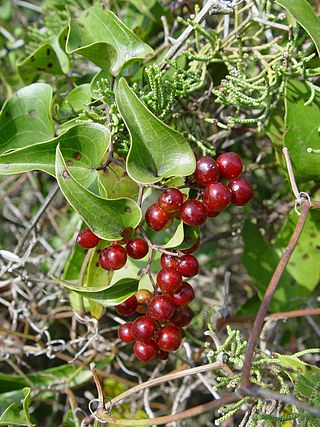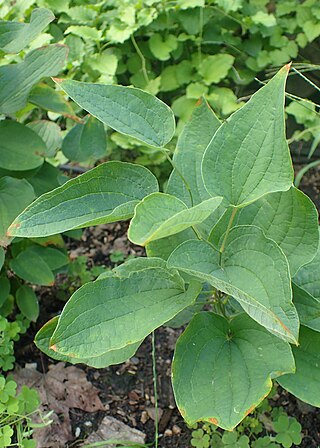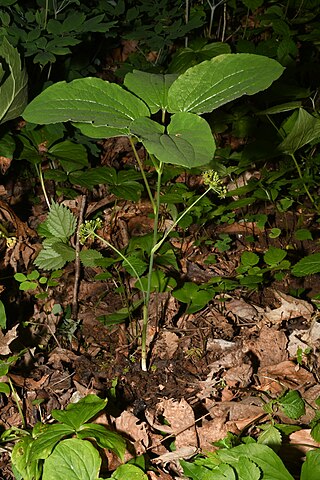
Smilacaceae, the greenbriers, is a family of flowering plants. While they were often assigned to a more broadly defined family Liliaceae, most recent botanists have accepted the two as distinct families, diverging around 55 million years ago during the Early Paleogene. One characteristic that distinguishes Smilacaceae from most of the other members of the Liliaceae-like Liliales is that it has true vessels in its conducting tissue. Another is that the veins of the leaves, between major veins, are reticulate (net-shaped), rather than parallel as in most monocots.

Smilax is a genus of about 300–350 species, found in the tropics and subtropics worldwide. They are climbing flowering plants, many of which are woody and/or thorny, in the monocotyledon family Smilacaceae, native throughout the tropical and subtropical regions of the world. Common names include catbriers, greenbriers, prickly-ivys and smilaxes. Sarsaparilla is a name used specifically for the Neotropical S. ornata as well as a catch-all term in particular for American species. Occasionally, the non-woody species such as the smooth herbaceous greenbrier are separated as genus Nemexia; they are commonly known by the rather ambiguous name carrion flowers.

Smilax sect. Nemexia is a section of plants in the family Smilacaceae. It consists of the herbaceous plants within the genus Smilax. Smilax species fall into two groups with distinctive morphologies: one group has woody perennial stems with thorns and a vining habit, while the other group has herbaceous stems that die back to the ground each winter. S. sect. Nemexia is the taxon that comprises the herbaceous species. In the past it was often a genus of its own under the name Nemexia and taxonomists still need further study of the species of Smilax to determine its proper rank. However the widely accepted taxonomic system of the Flora of North America does not recognize Nemexia, nor does the AP-site. Thus Nemexia is not currently considered an accepted genus taxon by most plant taxonomists.

Smilax rotundifolia, also known as roundleaf greenbrier or common greenbrier, is a woody vine native to the southeastern and eastern United States and eastern Canada. It is a common and conspicuous part of the natural forest ecosystems in much of its native range. The leaves are glossy green, petioled, alternate, and circular to heart-shaped. They are generally 5–13 cm long. Common greenbrier climbs other plants using green tendrils growing out of the petioles.

Smilax glauca, the cat greenbriar or catbriar is a woody vine in the family Smilacaceae. It is native to central and eastern portions of the United States as well as Mexico, where it is a common and conspicuous part of the forest vegetation.

Smilax jamesii is a species of flowering plant in the greenbriar family known by the common name English Peak greenbriar. It is to northern California, where it is known from the Klamath Mountains and the southernmost peaks of the Cascade Range. It has also been reported from nearby locations in southwestern Oregon. It grows in moist areas such as lakesides and streambanks in mountain coniferous forest habitat. It was discovered to be a new species when herbarium specimens thought to be Smilax californica were reexamined.

Smilax laurifolia is a species of flowering plant in the greenbrier family known by the common names laurel greenbrier, laurelleaf greenbrier, bamboo vine, and blaspheme vine. It is native to the southeastern United States, where it occurs along the Gulf and Atlantic coastal plains from Texas to New Jersey, the range extending inland to Arkansas, Oklahoma, and Tennessee. It also occurs in Cuba and the Bahamas.

Smilax bona-nox, the saw greenbrier, is a species of plant in the family Smilacaceae. It is native to the Southern United States, and eastern Mexico.
Smilax moranensis is a plant species in the family Smilacaceae. It is native to mountainous areas in Mexico from Sonora and Chihuahua south to Chiapas.

Symphyotrichum dumosum is a species of flowering plant of the family Asteraceae commonly known as rice button aster and bushy aster. It is native to much of eastern and central North America, as well as Haiti and Dominican Republic. It is a perennial, herbaceous plant that may reach a height of 1 meter.

Styrax americanus, the American snowbell or mock-orange, is a plant species native to the southeastern United States and the Ohio Valley. It has been reported from Texas and Florida to Virginia and Missouri. It generally grows in swamps and on floodplains and in other wet locations.

Samolus ebracteatus, the limewater brookweed, is a plant species known to Mexico, Central America, the West Indies, and to the United States. It is found in wetlands, including seashore salt marshes, and near springs and intermittent rivers in desert areas.

Parietaria floridana, common name Florida pellitory, is a plant species native to the southeastern United States, the West Indies, and much of Latin America. In the US, the heart of its range extends from Florida, to Georgia and North and South Carolina, with isolated populations reported in Mississippi, Louisiana, Texas, New Hampshire, Kentucky and Delaware. Some populations in California have in the past been referred to as P. floridana but are now regarded as a separate species, P. hespera.
Smilax havanensis is a plant species native to Cuba, the Cayman Islands, Bahamas, Turks & Caicos, and southern Florida.

Smilax hugeri, common name Huger's carrionflower, is a North American plant species native to the south-eastern United States. It is found in Mississippi, Alabama, Georgia, Florida, Tennessee, and North and South Carolina.

Smilax pulverulenta, the downy carrionflower, is a North American species of plants native to the eastern and central United States. The plant is fairly common in the Ozarks, the Appalachians, and the Mid-Atlantic States, with isolated populations in Rhode Island, Minnesota, and Nebraska.
Smilax pumila, the sarsaparilla vine, is a North American species of plants native to the southeastern United States from eastern Texas to South Carolina.

Smilax tamnoides, common name bristly greenbrier, is a North American species of plants native to the United States and Canada. It is widespread from Ontario and New York State south to Texas and Florida.
Smilax walteri, common names coral greenbrier, red-berried greenbrier or red-berried bamboo, is a North American species of plant found only in the United States. It is native to coastal plains in the south-central, southeastern, and east-central parts of the country, from eastern Texas to New Jersey.















